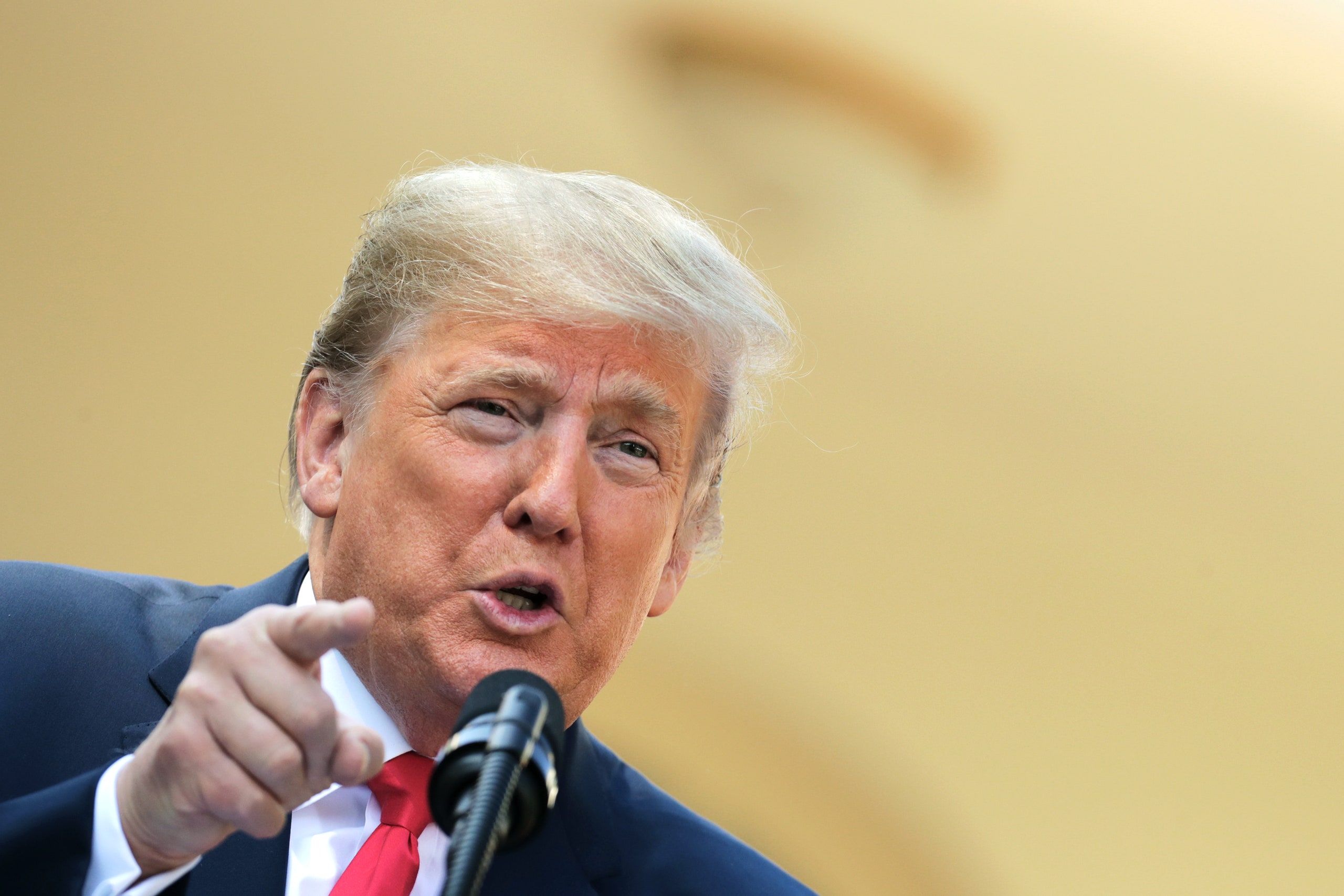Trump's Trade Deal Push: Downplaying Economic Risks?

Table of Contents
The Rhetoric of Protectionism: Selling the Trade Deals to the Public
Trump and his administration employed powerful rhetoric to promote their trade deals, effectively framing them as crucial for American economic resurgence. This messaging skillfully leveraged existing anxieties and sentiments within the electorate.
- Emphasis on bringing back jobs: The narrative consistently highlighted the return of manufacturing jobs lost to overseas competition, resonating with blue-collar workers and communities affected by globalization. Slogans like "America First" and promises to "Make America Great Again" were central to this messaging.
- Focus on unfair trade practices by other countries: The administration frequently accused other nations of engaging in unfair trade practices, such as dumping and intellectual property theft, justifying the need for protectionist measures as a response to these perceived injustices. This resonated with those who felt the existing trade system was rigged against the US.
- Nationalistic framing of the trade deals: The trade deals were presented not merely as economic agreements but as expressions of national pride and sovereignty. This nationalistic framing tapped into a potent wellspring of patriotic sentiment.
- Downplaying potential negative consequences for consumers and businesses: Potential negative consequences for consumers (e.g., higher prices) and businesses (e.g., supply chain disruptions) were often minimized or ignored in the public discourse, focusing instead on the perceived short-term benefits.
This carefully crafted rhetoric influenced public opinion, shaping the political debate and creating a climate receptive to protectionist policies, even if the long-term economic consequences were less clear. The effective use of keywords like "American Jobs" and "Protectionism" amplified the message across media platforms.
Increased Tariffs and Their Impact on Businesses and Consumers
A core element of Trump's trade policy was the imposition of increased tariffs on imported goods. While intended to protect domestic industries, these tariffs had far-reaching consequences.
- Rising prices for imported goods: Tariffs directly increased the price of imported goods, leading to higher consumer prices for a wide range of products, from steel and aluminum to consumer electronics. This effectively acted as a regressive tax, disproportionately affecting low-income households.
- Retaliatory tariffs from other countries: Other countries responded to US tariffs with their own retaliatory measures, creating a trade war that disrupted global commerce. This hurt both US exporters and importers.
- Disruption of supply chains: The imposition of tariffs and trade restrictions disrupted established supply chains, leading to production delays, shortages, and increased costs for businesses.
- Impact on small businesses and farmers: Small businesses and farmers, often lacking the resources to navigate complex trade regulations and absorb increased costs, were particularly vulnerable to the negative consequences of the trade war.
Industries like agriculture and manufacturing faced significant challenges. Statistical data from this period clearly shows increases in inflation and a slowdown in economic growth in certain sectors, highlighting the tangible economic impact of Trump's trade policies.
Renegotiated Trade Deals: A Critical Analysis of USMCA and Other Agreements
Trump's administration renegotiated several existing trade agreements, most notably the North American Free Trade Agreement (NAFTA), replacing it with the United States-Mexico-Canada Agreement (USMCA).
- Changes to NAFTA: USMCA introduced changes to NAFTA, aiming to enhance protections for American industries and workers. These included stricter rules of origin for automobiles, strengthened intellectual property protections, and revised dispute resolution mechanisms.
- Focus on protecting American industries: The renegotiated deals prioritized protecting specific American industries, often at the expense of broader free trade principles. This approach prioritized bilateral agreements, shifting away from multilateral trade deals.
- Controversial aspects of the agreements: Several aspects of the renegotiated deals proved controversial, sparking debate among economists and policymakers regarding their long-term impact on economic efficiency and competitiveness.
- Short-term vs. long-term economic effects: While some proponents argued for short-term gains in certain sectors, critics questioned the long-term economic sustainability of protectionist measures.
A comparative analysis of NAFTA and USMCA reveals both subtle and significant alterations in trade regulations, highlighting the shift in the US government's approach to international trade. The long-term effects, however, remain a subject of ongoing debate and research.
Long-term Economic Risks and Uncertainties
Trump's trade policies introduced significant long-term economic risks and uncertainties.
- Increased trade tensions with other countries: The trade war initiated under Trump's administration significantly damaged relationships with key trading partners, increasing overall global trade tensions.
- Damage to international relationships: Protectionist policies strained diplomatic relations with numerous countries, potentially undermining future international collaborations on other crucial issues.
- Unpredictability in global markets: The unpredictable nature of Trump's trade policy decisions created uncertainty in global markets, making it difficult for businesses to plan for the future. This unpredictability undermined investor confidence and slowed investment in key sectors.
- Impact on future economic growth: The long-term impact of Trump's trade policies on US economic growth remains a subject of debate, with some analysts predicting slower growth due to reduced trade and investment.
Different policy choices could lead to different outcomes. Understanding these potential scenarios is vital to formulating effective future trade policies that prioritize sustainable economic growth and robust international relations. The keywords "Global Trade" and "Economic Uncertainty" capture the core challenges stemming from these trade policies.
Conclusion
Trump's trade deal push, while presented as a path to economic prosperity, involved significant risks that were often downplayed. The increased tariffs, renegotiated trade agreements, and heightened trade tensions created uncertainty and had demonstrable effects on businesses and consumers. Analyzing the full impact requires examining the long-term implications for the US economy and its standing in the global marketplace.
Call to Action: Understanding the complexities of Trump's trade deal push is crucial for informed discussion on future trade policy. Further research into the long-term economic effects of these policies is needed to avoid repeating similar mistakes. Let's engage in a thoughtful conversation about the future of Trump's trade deal push and its impact on the American economy. We must carefully analyze the successes and failures of this approach to inform the development of more effective and sustainable trade strategies in the future.

Featured Posts
-
 Colman Domingo And Marco Calvani Shine In The Four Seasons
May 06, 2025
Colman Domingo And Marco Calvani Shine In The Four Seasons
May 06, 2025 -
 How To Watch Gypsy Rose Life After Lockup Season 2
May 06, 2025
How To Watch Gypsy Rose Life After Lockup Season 2
May 06, 2025 -
 Fortnite Sabrina Carpenter Skins Locations And Methods
May 06, 2025
Fortnite Sabrina Carpenter Skins Locations And Methods
May 06, 2025 -
 Fortnite Sabrina Carpenter Skin A Complete Guide
May 06, 2025
Fortnite Sabrina Carpenter Skin A Complete Guide
May 06, 2025 -
 Polski Trotyl Ogromne Zamowienie Na Rynkach Zagranicznych
May 06, 2025
Polski Trotyl Ogromne Zamowienie Na Rynkach Zagranicznych
May 06, 2025
